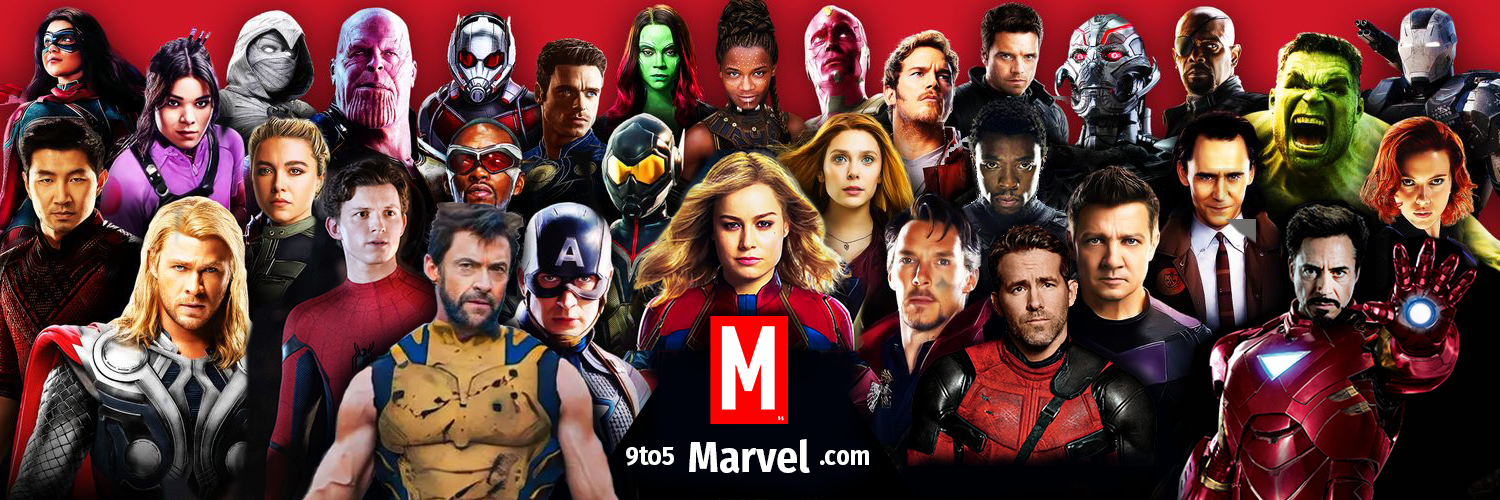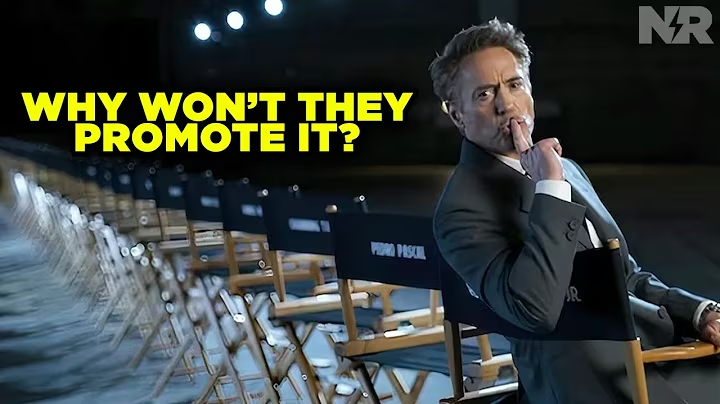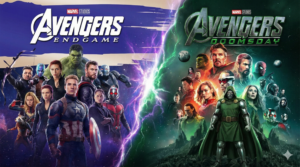With Avengers: Doomsday just over a year away and production already wrapped, a troubling question looms over Marvel Studios: Why is one of the world’s most valuable entertainment brands staying completely silent about a movie that needs to gross $2 billion to be profitable?
In a recent deep-dive analysis, New Rockstars hosts Erik Voss and Jessica Clemons dissect Marvel’s perplexing marketing strategy—or apparent lack thereof—and compare it to competitors who are far more transparent with their fanbases. The silence is deafening, especially considering this is a massive crossover event that could make or break Marvel’s theatrical future.
The Rumored December Trailer Drop
Rumors are swirling that Marvel will release the first Avengers: Doomsday trailer in front of Avatar: Fire and Ash when it hits theaters in December 2025. According to industry speculation, this won’t be the only major reveal—Sony’s Spider-Man: Brand New Day teaser and Christopher Nolan’s The Odyssey trailer may also debut during the same weekend.
While attaching trailers to major theatrical releases isn’t unprecedented (Nolan famously debuted his Tenet trailer exclusively in front of Hobbs & Shaw in August 2019 before releasing it online months later), the current situation feels different. It places enormous pressure on Avatar: Fire and Ash’s opening weekend to carry the marketing weight for three massive 2026 releases.
The reality is that most of these trailers will likely go online shortly after or simultaneously with their theatrical debut. Disney has done this before—the Fantastic Four trailer that played before Fire and Ash also went digital. But the symbolism of Marvel waiting this long to show anything substantial is what’s raising eyebrows across the industry.
A Studio That’s Forgotten How to Communicate
The most striking aspect of Marvel’s current approach is the studio’s refusal to let cast members even confirm their involvement. When Brie Larson appeared on The View this week to promote her cookbook, she was asked point-blank if she’d be in Avengers: Doomsday. Her response? “You know, I can’t answer that.”
Why is this basic information being treated as a state secret? James Gunn, by contrast, has been remarkably transparent about the DC Universe slate. He regularly shares behind-the-scenes photos, script covers, and updates on social media—content that costs literally zero dollars to produce but generates massive engagement and goodwill.
As Gunn himself noted in a recent interview with New Rockstars, “Sometimes you really benefit from going to Comic-Con and spending millions of dollars… But other times, I post a picture of the cover of a screenplay on Instagram for zero dollars and it gets just as much press.”
Marvel used to understand this. The studio sent Jon Favreau and Kevin Feige to Comic-Con in 2006—two years before Iron Man’s release—to show attendees an early trailer with unfinished effects, some of which never made it into the final film. They understood the importance of building a relationship with fans when Marvel Studios had no brand equity to leverage.
Twenty years later, with Marvel as a blue-chip entertainment brand, that philosophy has been abandoned.
The Comparison Problem: Everyone Else Is Doing It Better
Marvel’s silence becomes even more glaring when compared to how other studios and franchises manage fan relationships:
James Gunn’s DC Universe: Gunn maintains an active social media presence, sharing script pages, set photos, and engaging directly with fans. His approach has cultivated one of the most supportive and vocal fanbases in the superhero genre. When news breaks about DC projects, Gunn is often there to clarify, confirm, or redirect the conversation.
Eric Kripke’s The Boys Universe: Before Season 4 premiered, Kripke posted the first page of the season premiere script—containing zero spoilers but generating massive buzz. He regularly interacts with fans and keeps the momentum going between seasons.
Netflix’s Tudum: The streaming giant’s behind-the-scenes podcast features set visits, interviews with designers and crew, and detailed Easter egg breakdowns for shows like Wednesday, Stranger Things, and Squid Game. Fans get insight into the creative process without major spoilers.
Ryan Coogler’s Proximity Media: Even Coogler’s production company runs a weekly podcast featuring conversations with collaborators, discussing filmmaking philosophy and craft.
Apple TV+: Despite being newer to original content, Apple Studios aggressively markets properties like Severance and recent films, understanding that streaming success requires active audience cultivation.
Meanwhile, Marvel does have a weekly podcast on their YouTube channel, but it’s become a watered-down, over-produced affair that focuses on topics like “the sound design of Marvel Zombies” rather than substantive updates about upcoming films. It feels like a Disney Channel behind-the-scenes special rather than authentic fan engagement.
The Cost of Secrecy
Marvel’s tradition of secrecy served them well during the Infinity Saga when they had multiple releases per year creating natural momentum. With Black Panther premieres, Avengers press tours, and Spider-Man junkets happening every few months, Kevin Feige was constantly in front of microphones answering questions and building anticipation.
But in 2024-2025, that cadence has evaporated. Fantastic Four: First Steps released in July 2024, and that was the last major Marvel theatrical presence. Kevin Feige didn’t attend New York Comic-Con in October 2024—only Brad Winderbaum appeared to discuss television projects. When will Feige next face reporters? Possibly not until the Doomsday premiere itself, or perhaps at CinemaCon in April 2025.
This void has allowed misinformation and unfounded rumors to proliferate, forcing outlets to dedicate entire shows to “Rumor Rundowns” just to combat false information. As Voss pointed out, “In the silence that you have created, other liars have crept in that we have to do shows now called Rumor Rundown to shut down that sh*t.”
The March 2024 set chair livestream—where the Russo Brothers posted a cryptic photo with production chairs—likely cost upwards of $250,000 when you factor in renting Robert Downey Jr. for the day and all the production infrastructure. Yet that expensive stunt has yielded almost no follow-up content or sustained conversation.
For a fraction of that cost, Marvel could have someone posting weekly updates, script cover reveals, or concept art teases that would keep fans engaged and invested.
Why This Matters More Than Ever
2026 is shaping up to be a brutally competitive year. Christopher Nolan’s The Odyssey will dominate summer conversation. Sony’s Spider-Man: Brand New Day will pull focus as a Marvel-adjacent property. Meanwhile, Warner Brothers has no major releases in the first half of 2026, meaning fewer opportunities for theatrical marketing.
Avatar: Fire and Ash will be the last major theatrical release before a long dry spell, making it a crucial marketing opportunity—but also meaning Marvel can’t rely on other Disney releases to build Doomsday momentum.
Marvel has fewer theatrical releases than ever to create the interconnected hype that once made their crossover events feel inevitable and essential. Without that organic buildup, they’re expecting Avengers: Doomsday to simply materialize as a $2 billion success based solely on brand recognition and a single marketing push.
That’s an enormous gamble.
The Arrogance of Assumed Success
There’s an unmistakable arrogance in Marvel’s current posture—a “they’ll show up anyway” mentality that assumes the fanbase will remain engaged without cultivation. This mindset ignores how quickly audience enthusiasm can evaporate when neglected.
Consider that even Spider-Man: No Way Home, which didn’t confirm Tobey Maguire and Andrew Garfield in marketing materials, still released its first trailer four months before the December 2021 release date. Fans found the scrubbed-out heroes in the trailer footage anyway, but Sony and Marvel understood they needed to start building buzz early.
With Doomsday, we’re approaching that same four-month window, and there’s been virtually nothing.
Potential Concerns: Why the Silence?
Several theories might explain Marvel’s reticence:
- PR Risk Aversion: Disney has faced various PR controversies in recent years. There may be institutional fear that putting someone forward to engage with fans opens them up to harassment, difficult questions about casting controversies (like the Jonathan Majors situation), or social media pile-ons.
- Too Many Cooks: Unlike James Gunn, who serves as both filmmaker and studio head, Marvel has a complex hierarchy. Kevin Feige may not be chronically online, and there’s no empowered creative voice authorized to speak freely about projects.
- Structural Limitations: Directors and showrunners working for Marvel have noted they often don’t know what they’re allowed to include until late in production. Jessica Gao, showrunner of She-Hulk, described submitting a wish list of every superhero they wanted and being shocked when Marvel approved Daredevil. This uncertainty may extend to marketing—nobody knows what they can say, so everyone says nothing.
- Legacy Secrecy Culture: Marvel’s spoiler-phobic culture worked when they had 3-4 releases per year creating momentum. Now, that same culture has calcified into something counterproductive, with executives unable or unwilling to adapt to a new release cadence that requires different engagement strategies.
What Marvel Should Do
The solution isn’t complicated:
- Empower a Voice: Whether it’s Kevin Feige appearing on Marvel’s existing podcast for 10-15 minutes weekly, Brad Winderbaum being authorized to discuss film projects, or appointing a new executive to serve as fan liaison, Marvel needs someone authentically engaging with the audience.
- Low-Cost Content: Script covers, concept art, storyboard frames, set photos—James Gunn has proven these generate just as much press as expensive promotional events.
- Let Actors Talk: If Brie Larson is in Avengers: Doomsday, let her say so. If Chris Evans is back, confirm it. The secrecy isn’t building intrigue; it’s creating frustration.
- Revamp the Podcast: Make Marvel’s weekly podcast a genuine hub for news and conversation rather than a sanitized, over-produced marketing vehicle that says nothing of substance.
- Respect the Fans: The people who made Marvel Studios a $2 billion-per-movie proposition deserve to be treated like valued partners in the franchise, not passive consumers who should be grateful for whatever crumbs are thrown their way.
The Stakes Have Never Been Higher
Marvel is about to ask audiences to show up for Avengers: Doomsday in May 2026 and shell out for premium tickets, IMAX experiences, and potentially multiple viewings to push the film past $2 billion. They’re making this ask after a period of reduced theatrical output, mixed critical reception for some recent projects, and diminished cultural buzz.
In this environment, silence isn’t strategic—it’s risky.
James Gunn inherited a DC Universe that was in disarray and has spent every day since his appointment building goodwill, transparency, and excitement. He understands that in the modern media landscape, the conversation between creators and fans never stops.
Marvel Studios revolutionized blockbuster filmmaking by understanding what audiences wanted before they knew they wanted it. Kevin Feige and Jon Favreau went to Comic-Con in 2006 with an incomplete Iron Man trailer because they understood that early fan investment would pay dividends.
It’s time for Marvel to remember that lesson.
Conclusion: Breaking the Silence
As we await the rumored December trailer drop, one thing is clear: Marvel’s current approach to marketing Avengers: Doomsday is unsustainable and potentially damaging to the film’s prospects.
The studio that once understood the value of fan relationships has become complacent, assuming that brand recognition alone will carry them to box office success. Meanwhile, competitors are eating their lunch by being more transparent, more engaged, and more respectful of their audiences.
Christopher Nolan is already sharing details about The Odyssey, a film that releases after Doomsday. James Gunn freely discusses DC projects years away. Even Sony is more forthcoming about Spider-Man: Brand New Day.
Marvel’s silence might be strategic in their minds, but to fans, it feels like indifference. And in an entertainment landscape where audiences have infinite options competing for their attention and dollars, indifference is a luxury Marvel Studios can no longer afford.
The question isn’t whether Marvel will market Avengers: Doomsday—they obviously will. The question is whether they’ve waited too long and squandered months of potential momentum for a film that absolutely must succeed.
Only time will tell if Marvel’s gamble on secrecy pays off, or if their silence becomes the story that overshadows the film itself. One thing is certain: when that December trailer finally drops, it will need to be spectacular enough to make up for months of radio silence and reignite a fanbase that’s been left waiting in the dark far too long.




